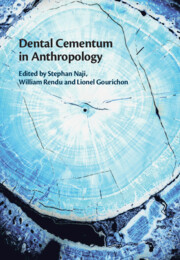Book contents
- Dental Cementum in Anthropology
- Dental Cementum in Anthropology
- Copyright page
- Dedication
- Contents
- Contributors
- Foreword
- Introduction: Cementochronology in Chronobiology
- Part I The Biology of Cementum
- 1 A Brief History of Cemental Annuli Research, with Emphasis upon Anthropological Applications
- 2 Development and Structure of Cementum
- 3 Insights into Cementogenesis from Human Disease and Genetically Engineered Mouse Models
- 4 A Comparative Genetic Analysis of Acellular Cementum
- 5 Pattern of Human Cementum Deposition with a Special Emphasis on Hypercementosis
- 6 Recent Advances on Acellular Cementum Increments Composition Using Synchrotron X-Radiation
- 7 Incremental Elemental Distribution in Chimpanzee Cellular Cementum: Insights from Synchrotron X-Ray Fluorescence and Implications for Life-History Inferences
- 8 Identifying Life-History Events in Dental Cementum: A Literature Review
- Part II Protocols
- Part III Applications
- Index
- Plate Section (PDF Only)
- References
4 - A Comparative Genetic Analysis of Acellular Cementum
from Part I - The Biology of Cementum
Published online by Cambridge University Press: 20 January 2022
- Dental Cementum in Anthropology
- Dental Cementum in Anthropology
- Copyright page
- Dedication
- Contents
- Contributors
- Foreword
- Introduction: Cementochronology in Chronobiology
- Part I The Biology of Cementum
- 1 A Brief History of Cemental Annuli Research, with Emphasis upon Anthropological Applications
- 2 Development and Structure of Cementum
- 3 Insights into Cementogenesis from Human Disease and Genetically Engineered Mouse Models
- 4 A Comparative Genetic Analysis of Acellular Cementum
- 5 Pattern of Human Cementum Deposition with a Special Emphasis on Hypercementosis
- 6 Recent Advances on Acellular Cementum Increments Composition Using Synchrotron X-Radiation
- 7 Incremental Elemental Distribution in Chimpanzee Cellular Cementum: Insights from Synchrotron X-Ray Fluorescence and Implications for Life-History Inferences
- 8 Identifying Life-History Events in Dental Cementum: A Literature Review
- Part II Protocols
- Part III Applications
- Index
- Plate Section (PDF Only)
- References
Summary
This chapter details a comparative genetic analysis of several candidate genes associated with acellular cementum, namely ALPL, BMP-2, BMP-7, and ARNTL. More than 40 species of mammals, reptiles, and birds were included in this analysis. For each gene, we investigated the type of selection that best characterized its evolutionary history, identified species in which these genes were recently subject to positive selection, and demonstrated specific behavioral and morphological characteristics that influence the selection pressure on these genes. We found that, overall, ALPL, BMP-2, BMP-7, and ARNTL have been subject to purifying selection in the examined taxa; however, recent positive selection on three of these genes was identified in species that have experienced recent, rapid evolutionary changes in dental anatomy. In addition, we found that several species-specific characteristics, including diet, lifespan, tooth count, and radicularity, significantly predicted lineage-specific selection pressure on these genes. This chapter demonstrates that cementum genes have undergone significant evolutionary changes, and that certain phenotypic characteristics have influenced such changes
- Type
- Chapter
- Information
- Dental Cementum in Anthropology , pp. 83 - 93Publisher: Cambridge University PressPrint publication year: 2022



